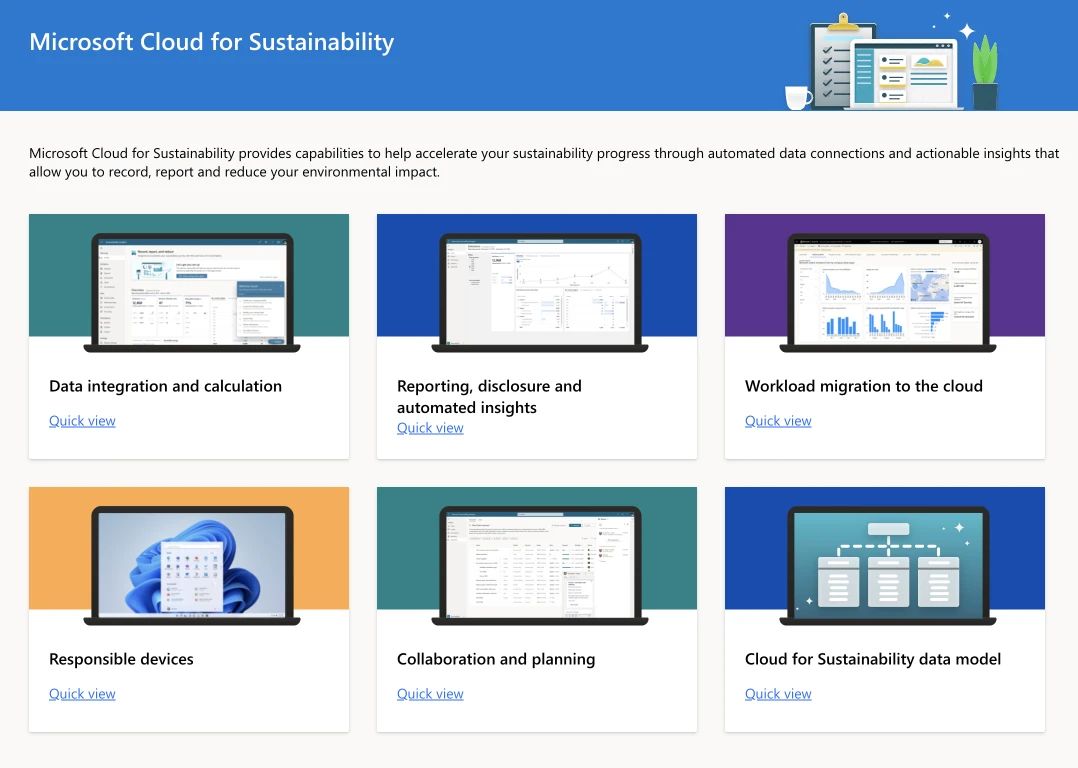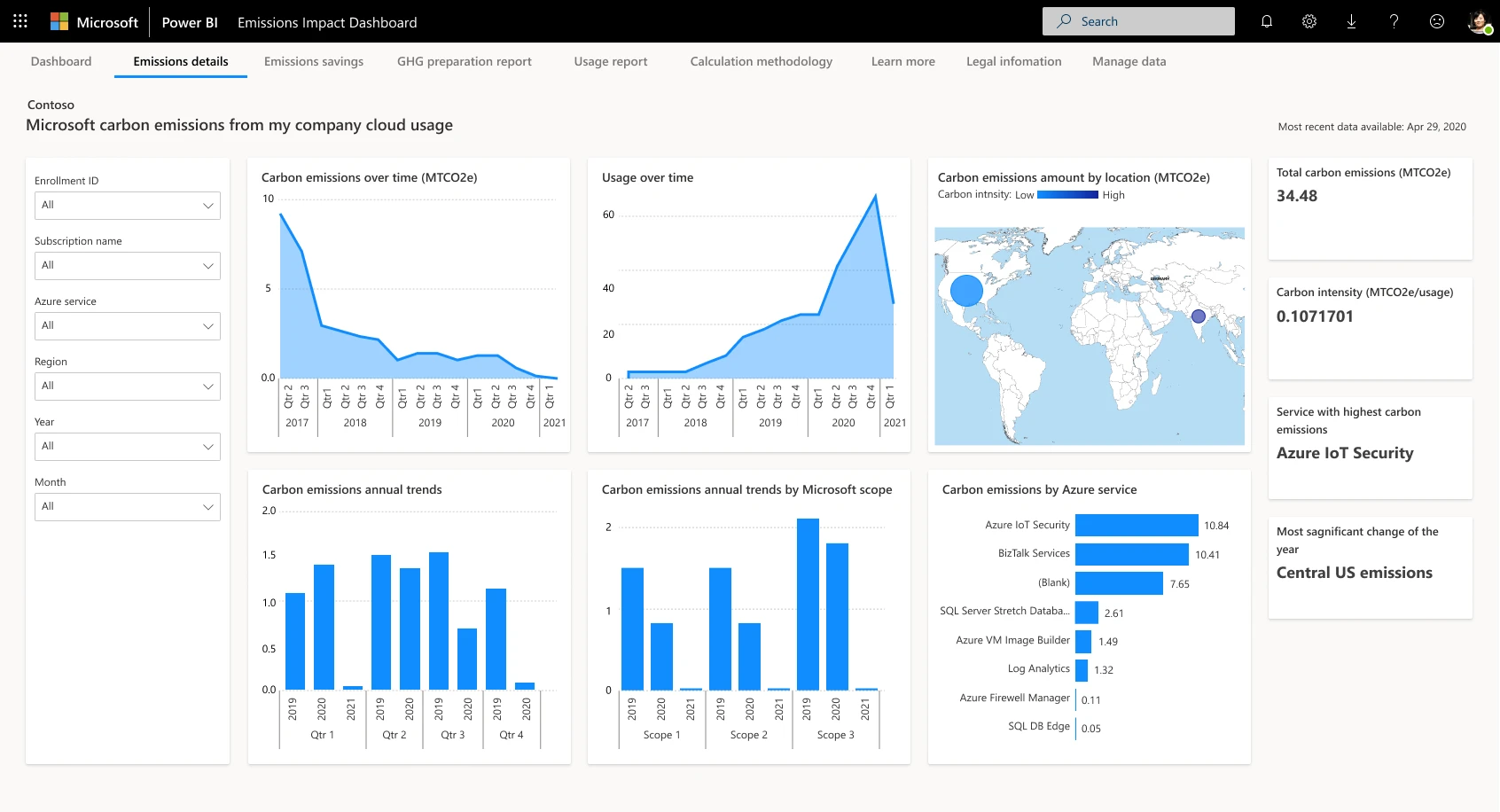
By Dominik Szeląg
Sustainability reporting is all about expertise and data engineering done by market leaders.From the business perspective, the current movement toward climate neutrality and associated new sustainability reporting policies are an opportunity. It is not just about being a greener, compliant company, but also about deeper analyzing and reorganizing its operations to find more efficient and cost-saving solutions. To achieve this, businesses need one manageable tool that provides trustful measures for supporting strategies, reporting processes, and tracking progress during organizational change. Microsoft, one of the tech giants, is now ready to present a response to the market’s need: they created a solution combining Power BI foundations and subject matter expertise. It is called Microsoft Cloud for Sustainability and it supports business journeys through ESG indicators: Environmental, Social, and Governance. Also, it allows measuring emissions from cloud solutions usage. It gives access to two modules: the main utility – The Sustainability Manager, and the additional tool – Emission Impact Dashboard. Together, they create a comprehensive response to a business’s needs.
What is Microsoft Sustainability Manager?
Microsoft Sustainability Manager is a complex tool that automates manual processes and enables the gathering of sustainable data. Also, it prepares reports, supports the reduction of environmental impacts and emissions, increases operational efficiency, and creates more sustainable value chains. It allows to set up KPIs and targets to track the progress. This could be extended by utilizing Microsoft equipment like Azure and Power Platform tools. Worth to mention that the trial version is available free of charge for one month.
Emission Impact Dashboard – Microsoft Sustainability Calculator – complements the Sustainability Manager solution. It is a Microsoft Cloud-based carbon tracking application available on Azure and Microsoft 365 which uses Power BI template apps to measure emissions and carbon savings potential. The methodology was designed to cover emissions from all 3 Scopes of impact and – what is important – carbon accounting was validated by experts from Stanford University in 2018.

Microsoft Cloud for Sustainability capabilities. Source: Microsoft Industry Blog
How does it resolve problems with ESG reporting?
Firstly, Microsoft Sustainability Manager is prepared by subject matter experts and IT market leaders who created an application that could be adjusted to any environmental, social, and governance data flow. It also allows matching it with different reporting schemes according to new European reporting requirements, local law policies, and internal business procedures. What is important, it has a clear and consistent methodology that might be easily checked and audited during the validation process by external auditors.
Secondly, it allows you to gather, analyze and track the dispersed data almost in real-time, so it can be easily integrated with any business system by automating data connections. It centralizes previously disparate data in a common data format and offers organizations an increasingly comprehensive view of the emissions impact on their entire operations and value chain. The potential adjustment requires specific Azure knowledge by writing a proper script but support from Power BI experts can always be provided to create any necessary change.

Microsoft Cloud for Sustainability integrates data and creates automated dashboards that enable comprehensive overview of ESG metrics.
Source: Microsoft Industry Blog
How to start?
Significantly, setting up Microsoft Sustainability Manager is quite a simple procedure. All you need to start is to gather dispersed data from excel, IoT, sensors, or meters using direct connections with external utilities. This may be carried out by company employees who understand the methodology or backed up by Microsoft data engineers who will organize the process of preparing the input for analysis. If the report is not enough, then Azure and Power Platform tools will help to create custom solutions. The next step is the pure magic of data analytics. Then, detailed reports and dashboards are created, providing the strategic and operational background. The analysis includes carbon emissions in reference to Scope 1, 2, and 3 impacts and all other streams which should be added to the reports and measurement flows. As a result, business gains not just compliance with the regulations which are based on data but also a reduction of the environmental leverage, while increasing operational efficiency and gaining an understanding of the impacts from a holistic value and supply chain perspective.

Setting up the solution is a simple process that has an immediate positive effect on your business planning.
To get a full picture of the reporting and its effect on a business, in the frames of Microsoft Cloud for Sustainability, exists an additional utility – The Emissions Impact Dashboard which is free from the cost perspective. This time you can get one more piece of information as an appendix to a Scope 3 impact from the point of digital cloud utilization. As previously mentioned, all the counting of this Microsoft tool is in reference to the carbon emissions generated by the usage of Azure and Microsoft Dynamics. The methodology was validated by Stanford University experts but even more interesting is the fact that Microsoft is one of the few cloud providers that supplies this level of transparency to customers while compiling reports for voluntary or statutory reporting requirements. This methodology enables Microsoft to provide customers with their direct and indirect cloud-based emissions totals. All are based on their specific hardware profiles and datacenters and encompass Azure services, M365 services, Gaming clouds, as well as Dynamics 365.

Emissions Impact Dashboard shows a broader perspective on how your business affects the environment. Source: Microsoft Industry Blog
What are the disadvantages?
At first glance, Microsoft Sustainability Manager is not a cheap solution with the price of 4 000 USD per tenant per month. The price includes utilization of the tool, dedicated customer support, and a data model. License also features data verse entitlement capped at: Database (10GB/month), File (20GB/month); Log (2GB/month). Additional usage will require the purchase of a data verse capacity add-on.
However, the tool is comprehensive, Microsoft Sustainability Manager still has several categories of Scope 3 which will be added in future updates of the methodology. It is worth mentioning that a specific data model for the chosen organization requires the assistance of a Microsoft specialist at the beginning of its development, especially in defining specific indicators and the entire database.
As for the Emissions Impact Dashboard, the main thing is that it is just limited to Microsoft solutions users. Also, the dashboard is currently in preview and only includes emissions associated with your organization’s usage of Exchange Online, SharePoint Online, OneDrive for Business, and Microsoft Teams. The Emissions Impact Dashboard is currently not supported for national cloud deployments. However, your historical emissions figures may be updated as Microsoft makes improvements to data accuracy and completeness.
Why is Microsoft Cloud for Sustainability worth investing in?
All companies are now in the middle of the shift towards sustainability and more environmentally friendly solutions. Mandatory reporting and strict environmental risk assessment policies force quick reorganization around the data collecting schemes in all value chains. Usually, business models use plenty of different IT systems with dispersed databases. It is not easy to reorganize procedures, and systems and get measurable data to make proper business decisions and at the same time send the mandatory ESG reports to the authorities. From that perspective, Microsoft Cloud for Sustainability package seems to be a comprehensive solution with the potential to be a wider tool that responds to all organizational needs. Starting from methodology backed by expert knowledge, through data engineering until complete ESG reporting, tracking the progress and wider value chain perspective which assist business decisions.
What seems to be crucial, with its entire flexibility could be customized for a wide range of business branches. Supporting continuous development could address the sustainability reporting needs of the banking, investment, and production sector especially impacted by new European legislation. Possibly also matches for needs of the dissipated retail industry and any other sales and service companies struggling with ESG regulations.
There are probably far cheaper solutions on the market but there are certainly only a few which could be in any way adjusted to respond to client’s needs with the support of the expertise of a market IT leader.
If you want to deep dive into the Microsoft Cloud for Sustainability solution or just need help understanding the ESG impact on your business and how the above tools could be adjusted to your demands do not hesitate to contact our ESG team at ESG@cloudsonmars.com
Read more about
…. and more on our blog.
